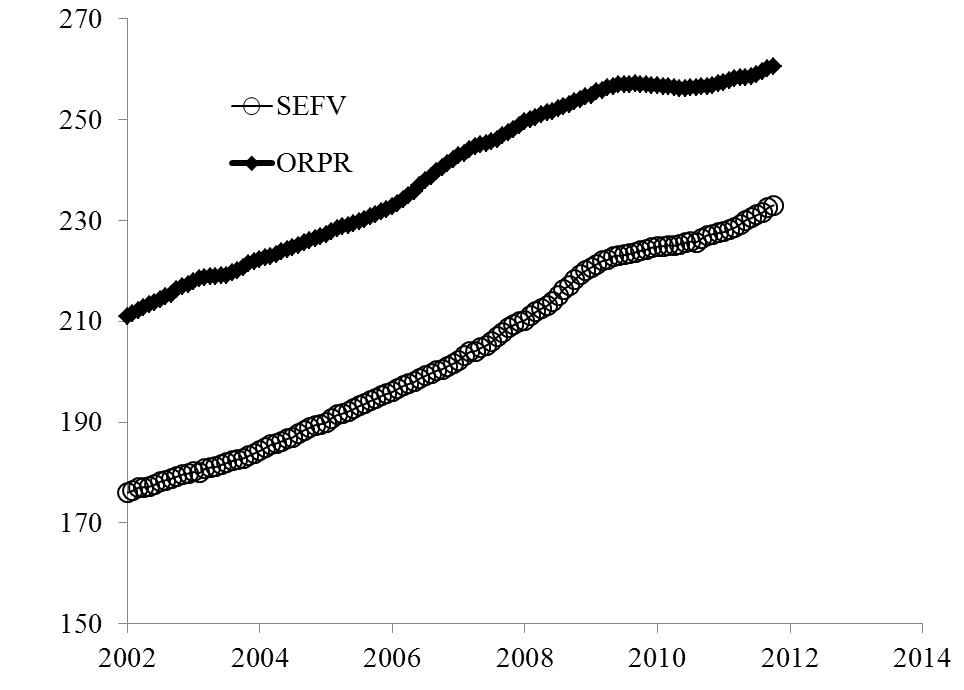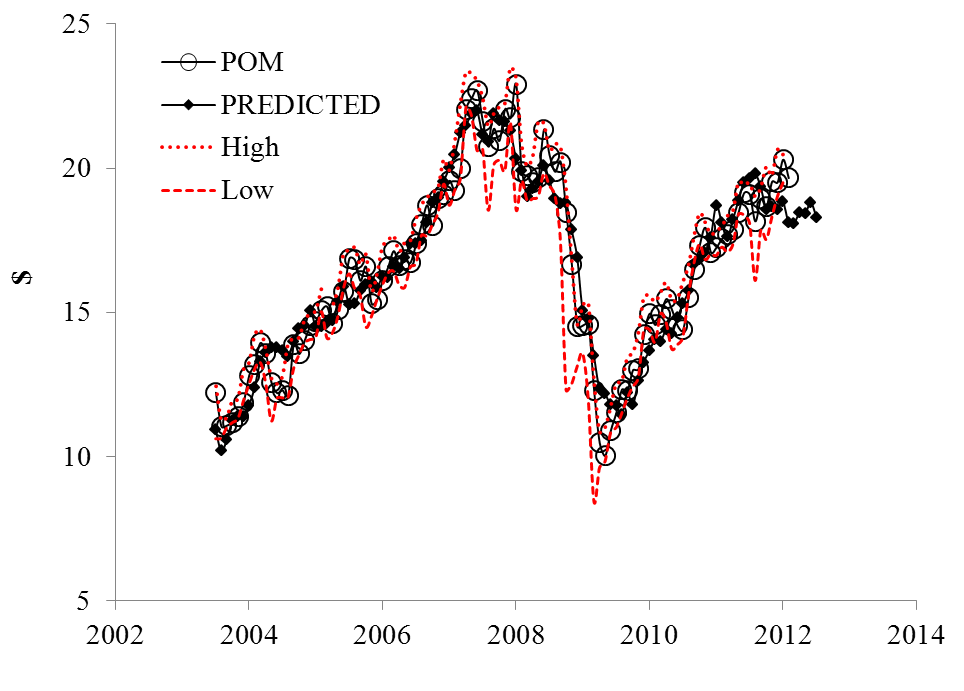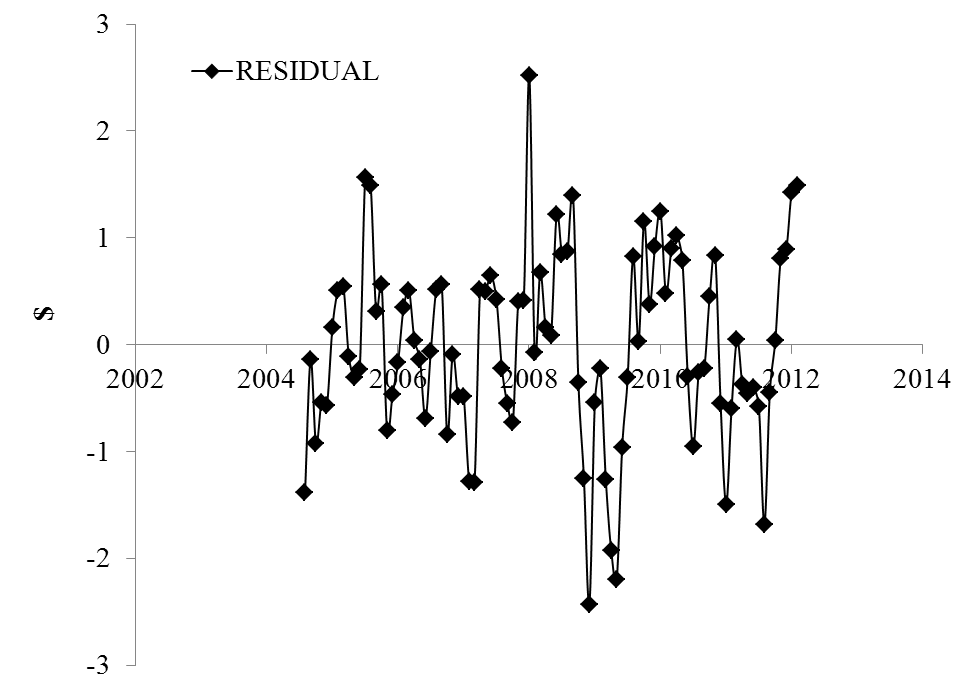In April 2011, we introduced a new model for Pepco Holdings (POM). The defining CPI indices were as follows: the index of food away from home (SEFV) and the index of owners' equivalent rent of residence (ORPR). (See model details in Appendix). Figure 1 depicts the evolution of these CPIs which lead the POM share price by 4 and 5 months, respectively. The best fit model, i.e. the lowermost RMS residual error, between July 2010 and March 2011:
POM(t) = -2.66SEVF(t-4) +1.06ORPR(t-5) +11.83(t-1990) + 101.35, March 2011
Where POM(t) is the share price in U.S. dollars, t is calendar time. The upper panel in Figure 2 displays the observed monthly closing price and that predicted by the above relationship.
In April, we predicted that “In the second quarter of 2011, the model foresees a rise by $1.5.” Actual monthly closing price has increased from $18.55 in March to $19.63 in June 2011. The predicted price is well within the high/low monthly bounds, i.e. practically within the uncertainty bounds of the POM price.
Here we revisit the initial model with new data available through January 2012. The model is stable and is defined by the same CPIs with similar coefficients. Time delays are also similar but the SEVF leads the share price by 5 months:
POM(t) = -2.19SEVF(t-5) +0.76ORPR(t-5) +10.57(t-1990) + 95.97, January 2012
In the lower panel of Figure 2, we show the current model and the uncertainty bounds as presented high and low monthly prices. The overall fit is good and we expect the current price to fall in the 2012Q1. Figure 3 demonstrates that the model error in January 2012 is positive and it must fall back to 0 in the near future.
Figure 1. The evolution of defining CPI.

Figure 2. Observed and predicted POM share prices. 
Figure 3. The model error, stdev= $0.89
Appendix
In its general form, our pricing model is as follows:
sp(tj) = Σbi∙CPIi(tj-Di) + c∙(tj-2000 ) + d + ej (1)
where sp(tj) is the share price at discrete (calendar) times tj, j=1,…,J; CPIi(tj-Di) is the i-th component of the CPI with the time lag Di, i=1,..,I; bi, c and d are empirical coefficients of the linear and constant term; ej is the residual error, which statistical properties have to be scrutinized. By definition, the bets-fit model minimizes the RMS residual error. The time lags are expected because of the delay between the change in one price (stock or goods and services) and the reaction of related prices. It is a fundamental feature of the model that the lags in (1) may be both negative and positive. In this study, we limit the largest lag to eleven months. Apparently, this is an artificial limitation and might be changed in a more elaborated model.
System (1) contains J equations for I+2 coefficients. For POM we use a time series from July 2003 to January 2012, i.e. 105 monthly readings. Due to the negative effects of a larger set of defining CPI components their number for all models is (I=) 2. To resolve the system, we use standard methods of matrix inversion. Usually, solutions of (1) are stable with all coefficients far from zero. In the POM model, we use 92 CPI components. They are not seasonally adjusted indices and were retrieved from the database provided by the Bureau of Labor Statistics.
Due to obvious reasons, longer time series guarantee a better resolution between defining CPIs. In general, there are two sources of uncertainty associated with the difference between observed and predicted prices. First, we have taken the monthly close prices (adjusted for splits and dividends) from a large number of recorded prices: monthly and daily open, close, high, and low prices, their combinations as well as averaged prices. Second source of uncertainty is related to all kinds of measurement errors and intrinsic stochastic properties of the CPI and its components. One should also bear in mind all uncertainties associated with the CPI definition based on a fixed basket of goods and services, which prices are tracked in few selected places. Such measurement errors are directly mapped into the model residual errors. Both uncertainties, as related to stocks and CPI, also fluctuate from month to month.
- English (UK)
- English (India)
- English (Canada)
- English (Australia)
- English (South Africa)
- English (Philippines)
- English (Nigeria)
- Deutsch
- Español (España)
- Español (México)
- Français
- Italiano
- Nederlands
- Português (Portugal)
- Polski
- Português (Brasil)
- Русский
- Türkçe
- العربية
- Ελληνικά
- Svenska
- Suomi
- עברית
- 日本語
- 한국어
- 简体中文
- 繁體中文
- Bahasa Indonesia
- Bahasa Melayu
- ไทย
- Tiếng Việt
- हिंदी
Modeling Pepco Holdings' Share Price
Published 02/20/2012, 06:11 AM
Updated 07/09/2023, 06:31 AM
Modeling Pepco Holdings' Share Price
3rd party Ad. Not an offer or recommendation by Investing.com. See disclosure here or
remove ads
.
Latest comments
Install Our App
Risk Disclosure: Trading in financial instruments and/or cryptocurrencies involves high risks including the risk of losing some, or all, of your investment amount, and may not be suitable for all investors. Prices of cryptocurrencies are extremely volatile and may be affected by external factors such as financial, regulatory or political events. Trading on margin increases the financial risks.
Before deciding to trade in financial instrument or cryptocurrencies you should be fully informed of the risks and costs associated with trading the financial markets, carefully consider your investment objectives, level of experience, and risk appetite, and seek professional advice where needed.
Fusion Media would like to remind you that the data contained in this website is not necessarily real-time nor accurate. The data and prices on the website are not necessarily provided by any market or exchange, but may be provided by market makers, and so prices may not be accurate and may differ from the actual price at any given market, meaning prices are indicative and not appropriate for trading purposes. Fusion Media and any provider of the data contained in this website will not accept liability for any loss or damage as a result of your trading, or your reliance on the information contained within this website.
It is prohibited to use, store, reproduce, display, modify, transmit or distribute the data contained in this website without the explicit prior written permission of Fusion Media and/or the data provider. All intellectual property rights are reserved by the providers and/or the exchange providing the data contained in this website.
Fusion Media may be compensated by the advertisers that appear on the website, based on your interaction with the advertisements or advertisers.
Before deciding to trade in financial instrument or cryptocurrencies you should be fully informed of the risks and costs associated with trading the financial markets, carefully consider your investment objectives, level of experience, and risk appetite, and seek professional advice where needed.
Fusion Media would like to remind you that the data contained in this website is not necessarily real-time nor accurate. The data and prices on the website are not necessarily provided by any market or exchange, but may be provided by market makers, and so prices may not be accurate and may differ from the actual price at any given market, meaning prices are indicative and not appropriate for trading purposes. Fusion Media and any provider of the data contained in this website will not accept liability for any loss or damage as a result of your trading, or your reliance on the information contained within this website.
It is prohibited to use, store, reproduce, display, modify, transmit or distribute the data contained in this website without the explicit prior written permission of Fusion Media and/or the data provider. All intellectual property rights are reserved by the providers and/or the exchange providing the data contained in this website.
Fusion Media may be compensated by the advertisers that appear on the website, based on your interaction with the advertisements or advertisers.
© 2007-2024 - Fusion Media Limited. All Rights Reserved.
